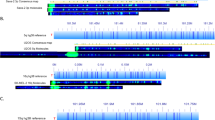Abstract
Telomeres are required for the complete duplication of the ends of linear chromosomes.Saccharomyces telomeres bear ∼350 bps of C1–3A/TG1–3 sequences. Previous work using non-denaturing Southern blotting has demonstrated the cell cycle controlled appearance of single stranded TG1–3 tails on chromosomal and plasmid telomeres (Wellinger et al. submitted). Furthermore it was shown that short linear plasmids carrying an origin of replication derived from 2 μm DNA can circularize at the time of telomere replication (Wellinger et al. submitted). Here we demonstrate that those loci previously shown to acquire single stranded tails are indeed telomeres and that single stranded TG1–3 cannot be observed in non-telomeric C1–3A/TG1–3-tracts. Moreover, we demonstrate that the formation of circular DNA by short linear plasmids is not restricted to plasmids containing a 2 μm origin of replication but can also be detected for plasmids containingARS1.
Similar content being viewed by others
References
Bell L, Byers B (1979) Occurrence of crossed strand-exchange forms in yeast DNA during meiosis. Proc. Natl. Acad. Sci. USA 76:3445–3449
Brewer BJ, Fangman WL (1987) The localization of replication origins on ARS plasmids in Saccharomyces cerevisiae. Cell 51: 463–471.
Brewer B.J., Sena EP, Fangman WL (1988) Analysis of replication intermediates by two-dimensional agarose gel electrophoresis. Cancer Cells 6: 229–234.
Chan CSM Tye B-K (1983a) A family ofSaccharomyces cerevisiae repetitive autonomously replication sequences that have very similar genomic environments. J. Molec. Biol. 168: 505–523.
Chan CSM, Tye B-K (1983b) Organization of DNA sequences and replication origins at yeast telomeres. Cell 33: 563–573.
Feinberg AP, Vogelstein B (1983) A technique for radiolabeling DNA restriction endonuclease fragments to high specific activity. Anal. Biochem. 132: 6–13.
Greider CW, Blackburn EH (1985) Identification of a specific telomere terminal transferase activity inTetrahymena extracts. Cell 43: 405–413
Henikoff S, Eghtedarzadeh MK (1987) Conserved arrangement of nested genes at the Drosophila Gart locus. Genetics 117: 711–725.
Hirt B (1967) Selective extraction of polyoma DNA from infected mouse cell cultures. J. Molec. Biol. 26: 365–369.
Huberman JA, Spotila LD, Nawotka KA, El-Assouli SM, Davis LR (1987) The in vivo replication origin of the yeast 2 μm plasmid. Cell 51: 473–481.
Irani M, Taylor WE, Young ET (1987) Transcription of theADH2 gene ofSaccharomyces cerevisiae is limited by positive factors that bind competitively to its intact promotor region on multicopy plasmids. Molec. Cell. Biol. 7: 1233–1241.
Jaeger D, Philippsen P (1989) Many yeast chromosomes lack the telomere specific Y' sequence. Molec. Cell. Biol. 9: 5754–5757.
Livingston DM, Kupfer DM (1977) Control of Saccharomyces cerevisiae 2 μm DNA replication by cell division cycle genes that control nuclear DNA replication. J. Molec. Biol. 116: 249–260.
Louis EJ, Haber JE (1990) The subtelomeric Y' repeat family inSaccharomyces cerevisiae: an experimental system for repeated sequence evolution. Genetics 124: 533–545.
Lundblad V, Szostak JW (1989) A mutant with a defect in telomere elongation leads to senescence in yeast. Cell 57: 633–643.
McCarroll RM, Fangman WL (1988) Time of replication of yeast centromeres and telomeres. Cell 54: 505–513.
Mirkovitch J, Mirault M-E, Laemmli UK (1984) Organization of the higher-order chromatin loop: specific DNA attachment sites on nuclear scaffold. Cell 39: 223–232.
Morin GB (1989) The human telomere terminal transferase enzyme is a ribonucleoprotein that synthesizes TTAGGG repeats. Cell 59: 521–529.
Pluta AF, Zakian VA (1989) Recombination occurs during telomere formation in yeast. Nature 337: 429–433.
Shampay J, Szostak JW, Blackburn EH (1984) DNA sequences of telomeres maintained in yeast. Nature 310: 154–157.
Shippen-Lentz D, Blackburn EH (1989) Telomere terminal transferase activity fromEuplotes crassus adds large numbers of TTTTGGGG repeats onto telomeric primers. Molec. Cell. Biol. 9: 2761–2764.
Stinchcomb DT, Mann C, Davis RW (1980a) Centromeric DNA fromSaccharomyces cerevisiae. J. Molec. Biol. 158: 157–190.
Stinchcomb DT, Thomas M, Kelly J, Selker E, Davis RW (1980b) Eukaryotic DNA segments capable of autonomous replication in yeast. Proc. Natl. Acad. Sci. USA 77: 4559–4563.
Tschumper G, Carbon J (1980) Sequence of a yeast DNA fragment containing a chromosomal replicator and the TRP1 gene. Gene 10: 157–166.
Wahl GM, Meinkot h JL, Kimmel AL (1987) Northern and Southern blots. Methods Enzymol. 152: 572–581.
Walmsley RM, Chan CSM, Tye B-K, Petes TD (1984) Unusual DNA sequences associated with the ends of yeast chromosomes. Nature 310: 157–160.
Watson JD (1972) Origin of concatemeric DNA. Nature (New Biology) 239: 197–201.
Wellinger RJ, Zakian VA (1989) Lack of positional requirements for autonomously replicating sequence elements on artificial yeast chromosomes. Proc. Natl. Acad. Sci. U. S. A. 86:973–977.
Yao M-C, Yao C-H (1981) Repeated hexanucleotide C-C-C-C-A-A is present near free ends of macronuclear DNA of tetrahymena. Proc. Natl. Acad. Sci. USA 78: 7436–7439.
Zahler AM, Prescott DM (1988) Telomere terminal transferase activity in the hypotrichous ciliateOxytricha nova and a model for replication of the ends of linear DNA molecules. Nucleic Acids Res. 16: 6953–6985.
Zakian VA (1989) Structure and function of telomeres. Annu. Rev. Genet. 23: 579–604.
Zakian VA, Blanton HM (1988) Distribution of telomere-associated sequences on natural chromosomes ofSaccharomyces cerevisiae. Molec. Cell. Biol. 8: 2257–2260.
Zakian VA, Brewer BJ, Fangman WL (1979) Replication of each copy of the yeast 2 micron DNA plasmid occurs during the S-phase. Cell 17: 923–934.
Author information
Authors and Affiliations
Rights and permissions
About this article
Cite this article
Wellinger, R.J., Wolf, A.J. & Zakian, V.A. Use of non-denaturing Southern hybridization and two dimensional agarose gels to detect putative intermediates in telomere replication inSaccharomyces cerevisiae . Chromosoma 102 (Suppl 1), S150–S156 (1992). https://doi.org/10.1007/BF02451800
Received:
Issue Date:
DOI: https://doi.org/10.1007/BF02451800




